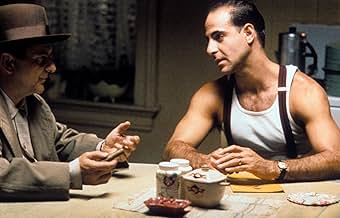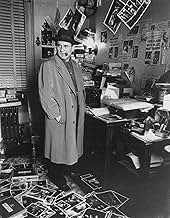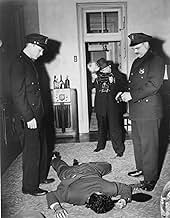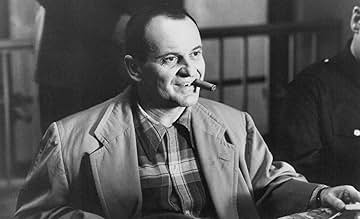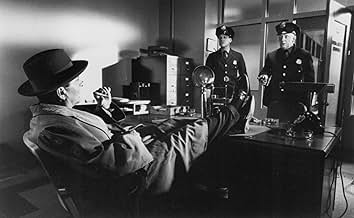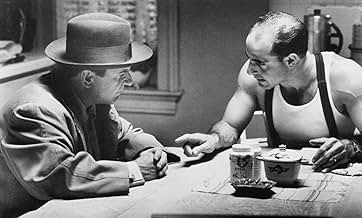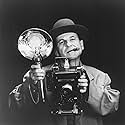NOTE IMDb
6,5/10
4,7 k
MA NOTE
Année 1942. Leon Berstein, le photographe le plus roublard de New York, est contacté par la belle Kay Levitz qui lui demande de réunir un dossier compromettant sur le gangster Spoleto.Année 1942. Leon Berstein, le photographe le plus roublard de New York, est contacté par la belle Kay Levitz qui lui demande de réunir un dossier compromettant sur le gangster Spoleto.Année 1942. Leon Berstein, le photographe le plus roublard de New York, est contacté par la belle Kay Levitz qui lui demande de réunir un dossier compromettant sur le gangster Spoleto.
- Réalisation
- Scénario
- Casting principal
- Récompenses
- 1 nomination au total
Christian Stolte
- Ambulance Attendant
- (as Christian Stolti)
Gian-Carlo Scandiuzzi
- Maitre D' - Cafe Society
- (as Gian-Carlo Scanduzzi)
Avis à la une
I picked this up at the local grocery never having heard about it before, I thought it was a comedy, it is not. Joe Pesci scores one for the little guy that nobody likes in a big way. There is one confusing thing however. Was that Walter Winchell he was supposed to be friends with? That part confused me. There was also something said about the American mob families working with the Italian mob families to overthrow Italy in the movie era 1942. Was that true? Over all I really enjoyed it and for once could not predict the outcome. If you want something a little different, this is it.
Movies should be able to transport you to the time and place without much effort. "The Public Eye" does so. I saw this in -- of all places -- a redeye bus trip from New York to DC, and this only enhanced the viewing enjoyment. This is definitely a movie to "get into the mood" for 40's noir, down to the gritty life of the City After Dark.
This one keeps getting overlooked as one of the best of the 90's. See this one.
This one keeps getting overlooked as one of the best of the 90's. See this one.
The Private Eye (1992)
This is a fictionalized story of the very real NYC crime photographer Weegee, and if you've seen pictures of Weegee or heard his story, Joe Pesci is the perfect cast for the role, coming right after "Goodfellas." He nails it, a terrific performance, even down to handling the cameras well.
Too bad the rest of the film is hit or miss. Maybe on the hit (good) side is the general set design and atmosphere. It feels like a slightly simplified and cleaned up 1942 Manhattan (where most or all of this occurs). And Barbara Hershey as the leading woman (not quite a femme fatale, it seems, but she has that look) is solid, especially with her hair up. You'll see, a good strong look. And the cameras are pretty right on (I'm a photographer, and I shoot with one of these 4x5 Graflex press cameras all the time), though at a glance it seemed that at least one of his Graflexes was a post-war model. We'll let that slip. And on the plus side it has to be said that Mark Isham's last minute hiring for the score was inspired, because it gives the movie the depth it needs.
The misses on the film are deeply integral to enjoying it all the way--the plot, the secondary actors, the direction. The latter is hard to pin down within the obvious and almost purposely clichéd plot, but you feel all along that the movie is put together functionally, as if the director knows most of all that these pieces have to go in order. But giving it flow, elegance, power, and even a convincing mise-en-scene is not just a matter of logic. It feels off, as it out of tune. It's especially noticeable because so much of the film is going right, including Pesci.
There is the question of why did they take Weegee (a.k.a. Arthur Fellig) and turn him into Bernzini (a.k.a. Leon Bernstein)--apparently it was a rights issue with the original story, but certainly the new story could have still been based on Weegee. The images in the film look like pseudo-Weegee moments as much as Pesci looks like Weegee, and Wikipedia says that some of these are actual Weegees. (I have my doubts, but who knows?) Both men had outrageous rubber stamps for the back of their prints that are almost identical--Weegee's said "Weegee the Great." The car is identical, for sure, and even the pace and the world are Weegee's.
Beyond all of this, the movie is entertaining if never commanding, and quite beautifully photographed--I'm talking the cinematography, now. My copy was VHS, and it doesn't sound like the DVD service through Amazon called the Universal Vault Series has very high standards (one user said it looked like VHS quality). I would think a full widescreen version would be worth the trouble--maybe try an Amazon instant play for $3. This says specifically that it is widescreen.
This is a fictionalized story of the very real NYC crime photographer Weegee, and if you've seen pictures of Weegee or heard his story, Joe Pesci is the perfect cast for the role, coming right after "Goodfellas." He nails it, a terrific performance, even down to handling the cameras well.
Too bad the rest of the film is hit or miss. Maybe on the hit (good) side is the general set design and atmosphere. It feels like a slightly simplified and cleaned up 1942 Manhattan (where most or all of this occurs). And Barbara Hershey as the leading woman (not quite a femme fatale, it seems, but she has that look) is solid, especially with her hair up. You'll see, a good strong look. And the cameras are pretty right on (I'm a photographer, and I shoot with one of these 4x5 Graflex press cameras all the time), though at a glance it seemed that at least one of his Graflexes was a post-war model. We'll let that slip. And on the plus side it has to be said that Mark Isham's last minute hiring for the score was inspired, because it gives the movie the depth it needs.
The misses on the film are deeply integral to enjoying it all the way--the plot, the secondary actors, the direction. The latter is hard to pin down within the obvious and almost purposely clichéd plot, but you feel all along that the movie is put together functionally, as if the director knows most of all that these pieces have to go in order. But giving it flow, elegance, power, and even a convincing mise-en-scene is not just a matter of logic. It feels off, as it out of tune. It's especially noticeable because so much of the film is going right, including Pesci.
There is the question of why did they take Weegee (a.k.a. Arthur Fellig) and turn him into Bernzini (a.k.a. Leon Bernstein)--apparently it was a rights issue with the original story, but certainly the new story could have still been based on Weegee. The images in the film look like pseudo-Weegee moments as much as Pesci looks like Weegee, and Wikipedia says that some of these are actual Weegees. (I have my doubts, but who knows?) Both men had outrageous rubber stamps for the back of their prints that are almost identical--Weegee's said "Weegee the Great." The car is identical, for sure, and even the pace and the world are Weegee's.
Beyond all of this, the movie is entertaining if never commanding, and quite beautifully photographed--I'm talking the cinematography, now. My copy was VHS, and it doesn't sound like the DVD service through Amazon called the Universal Vault Series has very high standards (one user said it looked like VHS quality). I would think a full widescreen version would be worth the trouble--maybe try an Amazon instant play for $3. This says specifically that it is widescreen.
9sg60
I first saw The Public Eye about ten years ago knowing nothing about it in advance. This movie has really stayed with me over the years. It's very rich in atmosphere and I really bought into the characters. The whole cast was strong and the writing was very good. I read one review that complained that the romance wasn't believable. On the surface that might be understandable but the quality of the acting and the writing completely erased the issue for me. The 1940's setting was portrayed very effectively and the music added so much to the story. The scene with Kay Levitz going through Bernzini's photo album was very moving and captured the whole story in a nutshell for me. I strongly recommend this forgotten gem.
I've never rated this movie that high but I've gone back to it three times since it came out about 15 years ago on tape, so maybe I am underrating this. There still is no DVD of it, at least in Region I, and that's frustrating. There's something intriguing about this story that drives me back to it.
Perhaps that is so because it's about a photographer, something I did, too, while being in the newspaper business for years and an art form I've always enjoyed. The story also takes place in the 1940s and I love the style and atmosphere of that era which is beautifully shown here.
Joe Pesci is Leon Bernzini or "The Great Bernzini," a newspaper photographer and Barbara Hershey is a mysterious woman who Pesci has the hots for. There is a lot of mystery in here with Hershey's character. Pesci takes gruesome photos, doesn't get involved with anyone but he's willing to make an exception with "Kay Levitz" (Hershey)..... but is she good or bad for him?
Sad to say, the filmmakers kind of make a hero out of basically a sleazy guy who has few, if any, morals. ("Bernzy" was "paparazzi" before they invented the word!). The movie also has an unsatisfying ending, particularly with Hershey's character.
However, I keep getting drawn back into multiple viewings of this and I'd sure like to see what it looks like with a good DVD transfer.
Perhaps that is so because it's about a photographer, something I did, too, while being in the newspaper business for years and an art form I've always enjoyed. The story also takes place in the 1940s and I love the style and atmosphere of that era which is beautifully shown here.
Joe Pesci is Leon Bernzini or "The Great Bernzini," a newspaper photographer and Barbara Hershey is a mysterious woman who Pesci has the hots for. There is a lot of mystery in here with Hershey's character. Pesci takes gruesome photos, doesn't get involved with anyone but he's willing to make an exception with "Kay Levitz" (Hershey)..... but is she good or bad for him?
Sad to say, the filmmakers kind of make a hero out of basically a sleazy guy who has few, if any, morals. ("Bernzy" was "paparazzi" before they invented the word!). The movie also has an unsatisfying ending, particularly with Hershey's character.
However, I keep getting drawn back into multiple viewings of this and I'd sure like to see what it looks like with a good DVD transfer.
Le saviez-vous
- AnecdotesIt took Howard Franklin 10 years before he could get his screenplay turned into a film.
- GaffesWhen Kay leafs through Bernstein' photo album, there is picture of a New York City taxi with a rectangular roof light which displays not only the word "Taxi" but also whether the taxi is off duty and its medallion number. Those signs did not come into service until the 1960s. In the 1940s, when the movie is set, New York City taxis used a variety of curved roof lights used in most other cities.
- Citations
Kay Levitz: It doesn't matter what people say unless you believe them.
- Bandes originalesYou Can't Say No to a Soldier
(1942)
Music by Harry Warren
Lyrics by Mack Gordon
Performed by Sammy Kaye and His Orchestra
Courtesy of Sandy Hook Records
Meilleurs choix
Connectez-vous pour évaluer et suivre la liste de favoris afin de recevoir des recommandations personnalisées
- How long is The Public Eye?Alimenté par Alexa
Détails
Box-office
- Budget
- 15 000 000 $US (estimé)
- Montant brut aux États-Unis et au Canada
- 3 067 917 $US
- Week-end de sortie aux États-Unis et au Canada
- 1 139 825 $US
- 18 oct. 1992
- Montant brut mondial
- 3 067 917 $US
- Durée
- 1h 39min(99 min)
- Couleur
- Rapport de forme
- 1.85 : 1
Contribuer à cette page
Suggérer une modification ou ajouter du contenu manquant


